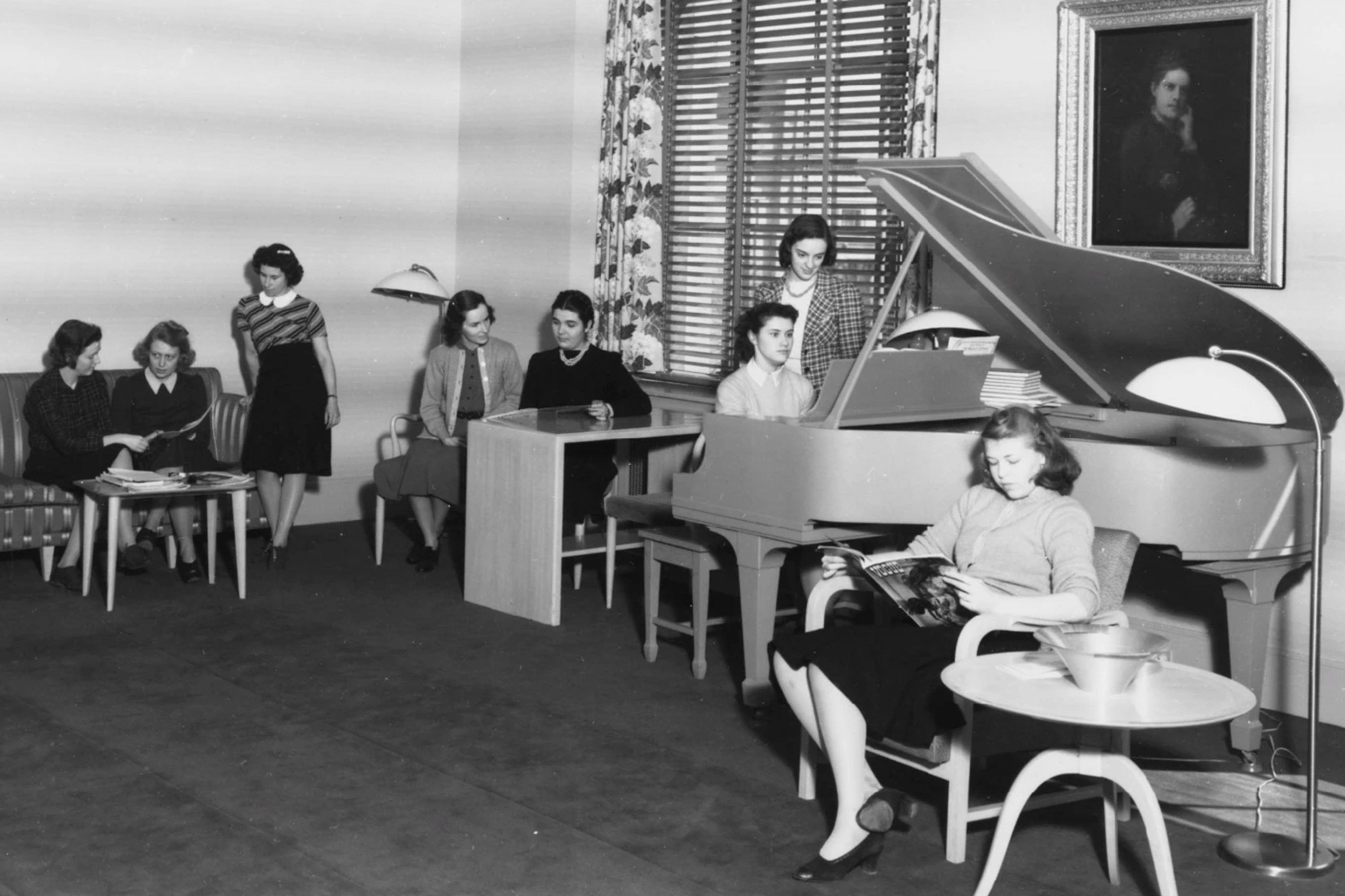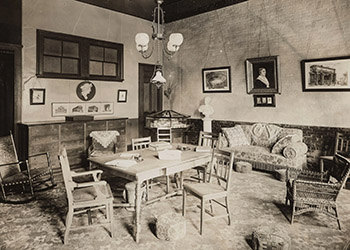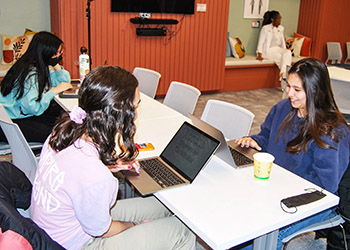A Home Away from Home
-
-
MIT Technology Review
- 1
Filed Under
Recommended

The Margaret Cheney Room Remains Indispensable After Nearly 140 Years
"The first time I used my key to enter the Cheney Room, I found myself in a large, beautiful, comfortable living room with a lovely grand piano,” says Catherine Monts Learoyd ’77, who discovered the space in the fall of 1975 while earning an undergraduate degree in electrical engineering. “As a musician, I immediately felt I had found a home away from home. While there were lockers, showers, and a quiet room to study, I always went into the kitchen and sat at the large dining table, where I would always find several other women between classes or having lunch. These women were from all different disciplines, so the conversation wouldn’t be about how to approach a problem on one’s homework, but more about friendship and supporting each other. These women of the Cheney Room were my life preserver, helping me stay afloat and energized to meet the considerable demands of my studies.”
The Cheney Room has been an oasis for MIT women ever since the original one opened on the Boston campus in 1884, when women at the Institute were scarce. Today’s enrollment numbers are much more balanced than in early days, with women making up 48 percent of the undergraduate and 39 percent of the graduate student body. But there’s still a need for dedicated spaces on campus where women and nonbinary students can gather, says Lauryn McNair, assistant dean of LBGTQ+ and Women and Gender Services at MIT.
Named after Margaret Cheney, a member of the Class of 1882 who died that year, the room was created at the urging of Ellen Swallow Richards (Class of 1873), the first woman to earn an MIT degree as well as its first female instructor, who wanted a space expressly for women to congregate. In the nearly 140 years since then, it has continued to serve the Institute’s women, changing and evolving along with their needs. Housed at 3-308 since 1939, the Cheney Room reopened in early 2023 after a renovation, offering new amenities, an updated layout, and a rich schedule of programming.
Serving Its Purpose(s)
“One of the most important sources of support during my eight years at MIT was the Cheney Room,” says Elizabeth Maria Sajdel-Sulkowska ’67, SM ’69, ScD ’72, who earned her master’s and doctoral degrees in nutrition and food science, following an undergrad degree in biology. “The Cheney Room was a place where I could relax, meet coed friends, get help, and learn about the ins and outs of the Institute. It had a bedroom with three to four beds, a bathroom with a shower, a large living room with interconnected couches, a study room with a view of the Great Court, and a telephone booth (there were no cell phones!); the kitchen was added during my graduate time. In December 1971, I moved to the Cheney Room for a few weeks to prepare my doctoral thesis for the February 1972 deadline. I followed a polyphasic sleep schedule, working for three hours and sleeping for 15 minutes around the clock. That’s how I wrote my thesis.”

When the Cheney Room first opened on the Boston campus, it offered the essentials for MIT’s few female students: a seating area, coat room, and toilets—the only ones available to women on campus in the 1800s. Bathing facilities and a kitchenette were added in 1898 upon the room’s relocation to the Pierce Building—crucial accommodations given that no Institute housing was available to women until 1945, when the MIT brownstone at 120 Bay State Road opened. Even that building provided fewer than 20 beds for women, so many continued to commute, and many alumnae say that they slept in the Cheney Room when they were too busy to travel home at the end of the day. That didn’t really change until McCormick Hall opened with hundreds of beds in 1963, thanks to funding from Katharine McCormick, Class of 1904, one of the first women to earn a bachelor’s in biology at MIT and a well-known suffragist and reproductive rights activist.
Inspiration Meets Renovation
“Women’s centers and spaces are still important, even in a changing landscape of gender,” says McNair, explaining that the space today is a haven for both women and nonbinary people. “At its foundation, a women’s space is built upon the core concepts of community through safety and support, access, affirmation and recognition, and intersectionality. I hope for students to feel at home in the Cheney Room and that this is a space for them that celebrates and affirms who they are so they can thrive at MIT.”
The latest renovation of the Cheney Room marks a new chapter. McNair, who started the new Women and Gender Services Office and oversees the space and programming, says that students played an integral role in the redesign process, offering input on everything from design choices to artwork.
Updates include reconfiguring old rooms to create new, more useful spaces and adding new furniture, fresh paint, and contemporary art that was created by female and nonbinary artists. After getting input from students, McNair chose the artworks to reflect how they see themselves in the world today. Those new pieces join a painting that has been a fixture since 1905—a portrait of Margaret Cheney.
One of the most noticeable changes is a new piano—an upright Yamaha N1X Grand Action Hybrid. While students loved, and many alumnae fondly remember, the grand piano that had graced the Cheney Room since the early 1900s (which has since been donated to Burton-Conner), this renovation called for more modern musical facilities. The new piano leaves more space for gathering and has the added bonus of being compatible with headphones (an encouraging feature for shy pianists).
Students who have long days away from their housing can still store small items like a laptop or purse in a new set of small and medium-sized lockers, which replaced larger ones that were gathering dust. The renovated Cheney Room accommodates a growing need for multipurpose space. It includes a lactation/quiet room, areas for virtual meetings, and even a conference room and event space. These facilities replaced the old showers and restrooms, which were not ADA compliant and which students felt were no longer needed. (There’s a women’s restroom across the hall from the Cheney Room.)
Cheney Room events are designed to foster community and connect students to resources for health, wellness, leadership, networking, and education. Examples include programming for Women’s History Month and Trans Day of Remembrance, talks with alums and industry leaders, gatherings that let students process the overturning of Roe v. Wade, and women’s leadership workshops.
Physics major Pamela Stark ’23 learned of the Cheney Room through an older classmate in her first year at the Institute. “Since then, I’ve used the space for so many purposes—the Cheney Room has felt like a steady source of belonging at MIT, and I am so grateful that I was introduced to it early on!” she says. “I’ve always loved that the Cheney Room feels like a part of women’s history at MIT. Even as MIT approaches gender parity, the need for women’s spaces continues to exist. This new renovation is going to change the aesthetics of the room a lot, but I expect that it’ll largely fill the same role as it used to—as a space with a lot of history where people come to find a safe space amongst their peers.”
The experiences of women like Learoyd testify to the Cheney Room’s role as a place to form cherished and lasting connections. The space was “one of the essential keys to the wonderful experience of MIT,” she says. “MIT was to me, like it is to many students, one of the first places you felt you belonged, and the Cheney Room and the women I met there strongly confirmed that I belonged at MIT—that I was truly an engineer at the heart of my being.

Photos: MIT Museum above and center; Julie Fox, bottom
This article also appears in the May/June issue of MIT News magazine, published by MIT Technology Review.








Comments
Sarah Simon
Tue, 05/16/2023 11:58am
Original Perspectives behind the Cheney Room
Julie,
Thank you for covering another aspect of the more than 150 years that women students have been part of the MIT experience.
Ellen H. Richards (nee Swallow, aka ESR) wasn't just looking for a place for women to gather - the argument against having women students at MIT and continuing to have the Women's Laboratory she led was that there were no accommodations for women.
ESR worked with Margaret Cheney's mother and other prominent women in her sphere to raise the money for MIT to provide/build the Cheney Room if they promised to continue to take women students. Mrs. Cheney later donated the money to move the room when MIT moved across the river to Cambridge.
(The need for a women's lounge, and perhaps why we now call toilet/washrooms "rest rooms," was more based on the reasoning that the "fair sex" could not function without a place to rest during the day. Remember, women were not franchised until more than 30 years later and, even up through the 1960's, could be dismissed from a job if they married or became pregnant.)
Another important purpose for retaining the Cheney Room with beds and showers is that women students, especially engineering and science grad students, need a safe place to sleep and eat while doing their laboratory work. While most students other than freshmen live off campus these days and have access to showers in the athletic facilities during activity hours (and food?), it is unfortunate that the previous functions were not supported in the renovation.
But, an update can always improve the spaces we inhabit and share. I look forward to hearing about how all of the women students on campus, e.g. PanHell, GWAMIT, etc, will be welcome in and make use of the renovated space.
Sarah Simon '72,
past president, Association of MIT Alumnae